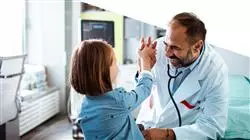University certificate
The world's largest faculty of psychology”
Why study at TECH?
TECH presents this Professional master’s degree as a unique opportunity to learn in detail the most innovative intricacies of Clinical Neuropsychology through a 100% online program"

The development of Neuropsychology has allowed for a deeper understanding of disorders through the exhaustive study of the relationship between the brain and the behavior of a given clinical case. Thanks to this, specialists in this branch of psychology have been able to perfect their diagnostic strategies based on what is observed in the patient, being able to adapt pharmacological treatments and cognitive-behavioral therapies in a more effective and personalized way, as well as positively influencing the improvement of the patient's quality of life.
However, it is a science that is evolving rapidly, and each year unveils new discoveries, which is why professionals in this sector must constantly update their knowledge in order to be able to offer the best service to their patients, based on the latest science. To this end, TECH and its team of experts in Psychology and Neurology have developed this very complete Professional Master's Degree in Clinical Neuropsychology.
It is a multidisciplinary and intensive program that will provide graduates with all the information they need to master the latest developments in this discipline. It will explore the bases of clinical neuropsychology, as well as the principles of neuroanatomy, with special emphasis on cognitive functions and the different types of neurobiological bases that are known today. It will also delve into brain damage and aphasia, agraphia and alexia, as well as cognitive deficits and neurodegenerative diseases. Finally, it will focus on the main techniques of neuropsychological evaluation and rehabilitation, and will conclude with an exhaustive review of the most effective pharmacological treatments, their recommendations and the cases in which they should be avoided.
All of this, through a 100% online program which includes 1500 hours of theoretical, practical and additional material chosen and designed by the teaching team. In addition, all the content will be available from the beginning of the academic program, and can be downloaded to any device with an internet connection for offline viewing, even after the program has been completed. It is, therefore, a unique opportunity to study a program adapted to the needs of the Psychology sector and to the most complex requirements of the profession.
You will be able to gain exhaustive knowledge about the bases and origins of this discipline, delving into the first authors and the most relevant works"
This Professional master’s degree in Clinical Neuropsychology contains the most complete and up-to-date scientific program on the market. Its most notable features are:
- Practical cases presented by experts in Psychology and Neurology
- The graphic, schematic, and practical contents with which they are created, provide scientific and practical information on the disciplines that are essential for professional practice
- Practical exercises where self-assessment can be used to improve learning
- Special emphasis on innovative methodologies
- Theoretical lessons, questions to the expert, debate forums on controversial topics, and individual reflection assignments
- Content that is accessible from any fixed or portable device with an Internet connection
You will be able to gain exhaustive knowledge about the bases and origins of this discipline, delving into the first authors and the most relevant works"
The teaching staff includes professionals from the field of psychology, who bring their experience to this Master’s program, as well as renowned specialists from leading scientific societies.
The multimedia content developed with the latest educational technology will provide the professional with situated and contextual learning, i.e., a simulated environment that will provide an immersive training program to train in real situations.
This program is designed around Problem Based Learning, whereby the student will must try to solve the different professional practice situations that arise during the course. For this purpose, the psychologist will be assisted by an innovative interactive video system created by renowned and experienced experts in the field of Clinical Neuropsychology with extensive teaching experience.
You'll take an in-depth review of functional neuroanatomy, from neuron composition to brain asymmetry"

A program designed in relation to the latest scientific advances in neuropsychology and that covers cognitive functions and the latest developments related to the different neurobiological bases"
Syllabus
In order to offer a unique and highly beneficial program for the academic and professional growth of the graduate, TECH has created this degree taking into account the criteria of the teaching team, who have been in charge of selecting all the information used to create the syllabus and additional material. In addition, following the criteria of quality and innovation that characterize this university, the program has been developed based on the Relearning methodology, with this center being as pioneer in its use. Thanks to this, the graduate will find in this Professional Master's Degree an opportunity to get up to date in a dynamic and entertaining way, without having to invest extra hours into memorizing the content.

In the virtual classroom you will find hundreds of hours of additional high-quality material for you to gain deeper knowledge of those aspects of the syllabus that you consider most relevant"
Module 1. Introduction to Neuropsychology
1.1. Introduction to Neuropsychology
1.1.1. Basis and Origins of Neuropsychology
1.1.2. First Approaches to the Discipline
1.2. First Approaches to the Neuropsychology
1.2.1. First Works Within Neuropsychology
1.2.2. Most Relevant Authors and Works
1.3. Ontogeny and Phylogeny of the CNS
1.3.1. Concept of Ontogeny and Phylogeny
1.3.2. Ontogeny and Phylogeny Within the CNS
1.4. Cellular and Molecular Neurobiology
1.4.1. Introduction to Neurobiology
1.4.2. Cellular and Molecular Neurobiology
1.5. Neurobiology of Systems
1.5.1. Concepts of Systems
1.5.2. Structures and Development
1.6. Embryology of the Nervous System
1.6.1. Principles of Embryology of the Nervous System
1.6.2. Phases of CNS Embryology
1.7. Introduction to Structural Anatomy CNS
1.7.1. Introduction to Structural Anatomy
1.7.2. Structural Development
1.8. Introduction to Functional Anatomy
1.8.1. What is Function Anatomy?
1.8.2. Most Important Functions
1.9. Neuroimaging Techniques
1.9.1. Concept of Neuroimaging
1.9.2. Most Commonly Used Techniques
1.9.3. Advantages and Disadvantages
Module 2. Principles of Neuroanatomy
2.1. Formation of the Nervous System
2.1.1. Anatomical and Functional Organization of the Nervous System
2.1.2. Neurons
2.1.3. Glial Cells
2.1.4. Central Nervous System: Brain and Spinal Cord
2.1.5. Main Structures
2.1.5.1. Forebrain
2.1.5.2. Midbrain
2.1.5.3. Rhombencephalon
2.2. Formation of the Nervous System II
2.2.1. Peripheral Nervous System
2.2.1.1. Somatic Nervous System
2.2.2.2. Neurovegetative or Autonomic Nervous System
2.2.2.3. White Matter
2.2.2.4. Gray Matter
2.2.2.5. Meninges
2.2.2.6. Cerebrospinal Fluid
2.3. The Neurone and its Composition
2.3.1. Introduction to the Neurone and its Function
2.3.2. The Neurone and its Composition
2.4. Electric and Chemical Synapses
2.4.1. What is a Synapse?
2.4.2. Electrical Synapse
2.4.3. Chemical Synapse
2.5. Neurotransmitters
2.5.1. What is a Neurotransmitter?
2.5.2. Types of Neurotransmitters and their Functioning
2.6. Neuroendocrinology (Hypothalamus-Endocrine System Relationship)
2.6.1. Introduction to Neuroendocrinology
2.6.2. Basis of Neuroendocrinological Functioning
2.7. Neuroimmunology (Relationship between the Nervous System and Immune System)
2.7.1. Introduction to Neuroimmunology
2.7.2. Basis and Fundamentals of Neuroimmunology
2.8. Nervous System in Childhood and Adolescence
2.8.1. Development of CNS
2.8.2. Bases and Characteristics
2.9. Nervous System in Adulthood
2.9.1. Bases and Characteristics of the CNS
2.10. Nervous System in Old Age
2.10.1. Bases and Characteristics of the CNS in Old Age
2.10.2. Main Related Problems
Module 3. Functional Neuroanatomy
3.1. Frontal Lobe
3.1.1. Introduction to the Frontal Lobe
3.1.2. Main Features
3.1.3. Bases of their Functioning
3.2. Neuropsychology of the Dorsolateral Prefrontal Cortex
3.2.1. Introduction to the Dorsolateral Prefrontal Cortex
3.2.2. Main Features
3.2.3. Bases of their Functioning
3.3. Neuropsychology of the Orbitofrontal Cortex
3.3.1. Introduction to the Orbitofrontal Cortex
3.3.2. Main Features
3.3.3. Bases of their Functioning
3.4. Neuropsychology of the Medial Prefrontal Cortex
3.4.1. Introduction to the Dorsolateral Prefrontal Cortex
3.4.2. Main Features
3.4.3. Bases of their Functioning
3.5. Motor Cortex
3.5.1. Introduction to the Motor Cortex
3.5.2. Main Features
3.5.3. Bases of their Functioning
3.6. Temporal Lobe
3.6.1. Introduction to the Temporal Lobe Cortex
3.6.2. Main Features
3.6.3. Bases of their Functioning
3.7. Parietal Lobe
3.7.1. Introduction to the Parietal Lobe Cortex
3.7.2. Main Features
3.7.3. Bases of their Functioning
3.8. Occipital Lobe
3.8.1. Introduction to the Occipital Lobe Cortex
3.8.2. Main Features
3.8.3. Bases of their Functioning
3.9. Cerebral Asymmetry
3.9.1. Concept of Brain Asymmetry
3.9.2. Characteristics and Functioning
Module 4. Cognitive Functions
4.1. Neurological Bases of Attention
4.1.1. Introduction to the Concept of Attention
4.1.2. Neurobiological Bases and Foundations of Attention
4.2. Neurobiological Bases of Memory
4.2.1. Introduction to the Concept of Memory
4.2.2. Neurobiological Bases and Foundations of Memory
4.3. Neurological Bases of Language
4.3.1. Introduction to the Concept of Language
4.3.2. Neurobiological Bases and Foundations of Language
4.4. Neurobiological Bases of Perception
4.4.1. Introduction to the Concept of Perception
4.4.2. Neurobiological Bases and Foundations of Perception
4.5. Visuospatial Neurobiological Bases
4.5.1. Introduction to Visuospatial Functions
4.5.2. Basis and Fundamentals of Visuospatial Functions
4.6. Neurobiological Basis of Executive Functions
4.6.1. Introduction to Executive Functions
4.6.2. Basis and Fundamentals of Executive Functions
4.7. Apraxias
4.7.1. What are Apraxias?
4.7.2. Features and Types
4.8. Gnosias
4.8.1. What are Apraxias?
4.8.2. Features and Types
4.9. Social Cognition
4.9.1. Introduction to Social Cognition
4.9.2. Characteristics and Theoretical Foundations
Module 5. Brain Injury
5.1. Neuropsychological and Behavior Disorders of Genetic Origin
5.1.1. Introduction
5.1.2. Genes, Chromosomes and Hereditary
5.1.3. Genes and Behavior
5.2. Early Brain Injury Disorder
5.2.1. Introduction
5.2.2. The Brain in Early Childhood
5.2.3. Pediatric Cerebral Palsy
5.2.4. Psychosyndromes
5.2.5. Learning Disorders
5.2.6. Neurobiological Disorders that Affect Learning
5.3. Vascular Brain Disorders
5.3.1. Introduction to Cerebrovascular Disorders
5.3.2. Most Common Types
5.3.3. Characteristics and Symptomology
5.4. Brain Tumors
5.4.1. Introduction to Brain Tumors
5.4.2. Most Common Types
5.4.3. Characteristics and Symptomology
5.5. Cranioencephalic Traumas
5.5.1. Introduction to Trauma
5.5.2. Most Common Types
5.5.3. Characteristics and Symptomology
5.6. Infections of the CNS
5.6.1. Introduction the CNS Infections
5.6.2. Most Common Types
5.6.3. Characteristics and Symptomology
5.7. Epileptic Disorders
5.7.1. Introduction to Epileptic Disorders
5.7.2. Most Common Types
5.7.3. Characteristics and Symptomology
5.8. Alterations in the Level of Consciousness
5.8.1. Introduction to Altered Levels of Consciousness
5.8.2. Most Common Types
5.8.3. Characteristics and Symptomology
5.9. Acquired Brain Injury
5.9.1. Concept of Acquired Brain Injury
5.9.2. Most Common Types
5.9.3. Characteristics and Symptomology
5.10. Disorders Related to Pathological Ageing
5.10.1. Introduction
5.10.2. Psychological Disorders Related to Pathological Ageing
Module 6. Aphasias, Agraphias and Alexias
6.1. Broca's Aphasia
6.1.1. Basis and Origin of Broca's Aphasia
6.1.2. Characteristics and Symptomology
6.1.3. Assessment and Diagnosis
6.2. Wernicke’s Aphasia
6.2.1. Basis and Origin of Wernicke's Aphasia
6.2.2. Characteristics and Symptomology
6.2.3. Assessment and Diagnosis
6.3. Conduction Aphasia
6.3.1. Basis and Origin of Conduction Aphasia
6.3.2. Characteristics and Symptomology
6.3.3. Assessment and Diagnosis
6.4. Global Aphasia
6.4.1. Basis and Origin of Global Aphasia
6.4.2. Characteristics and Symptomology
6.4.3. Assessment and Diagnosis
6.5. Sensory Transcortical Aphasia
6.5.1. Basis and Origin of Broca's Aphasia
6.5.2. Characteristics and Symptomology
6.5.3. Assessment and Diagnosis
6.6. Motor Transcortical Aphasia
6.6.1. Basis and Origin of Motor Transcortical Aphasia
6.6.2. Characteristics and Symptomology
6.6.3. Assessment and Diagnosis
6.7. Mixed Transcortical Aphasia
6.7.1. Basis and Origin of Mixed Transcortical Aphasia
6.7.2. Characteristics and Symptomology
6.7.3. Assessment and Diagnosis
6.8. Anomic Aphasia
6.8.1. Basis and Origin of Anomic Aphasia
6.8.2. Characteristics and Symptomology
6.8.3. Assessment and Diagnosis
6.9. Agraphias
6.9.1. Basis and Origin of Agraphias
6.9.2. Characteristics and Symptomology
6.9.3. Assessment and Diagnosis
6.10. Alexias
6.10.1. Basis and Origin of Alexias
6.10.2. Characteristics and Symptomology
6.10.3. Assessment and Diagnosis
Module 7. Cognitive Deficiencies
7.1. Attention Pathology
7.1.1. Main Attention Pathologies
7.1.2. Characteristics and Symptomology
7.1.3. Assessment and Diagnosis
7.2. Memory Pathology
7.2.1. Main Memory Pathologies
7.2.2. Characteristics and Symptomology
7.2.3. Assessment and Diagnosis
7.3. Dysexecutive Syndrome
7.3.1. What is Dysexecutive Syndrome?
7.3.2. Characteristics and Symptomology
7.3.3. Assessment and Diagnosis
7.4. Apraxias I
7.4.1. Concept of Apraxia
7.4.2. Main Modalities
7.4.2.1. Ideomotor Apraxia
7.4.2.2. Ideational Apraxia
7.4.2.3. Constructional Apraxia
7.4.2.4. Clothing Apraxia
7.5. Apraxias II
7.5.1. Gait Apraxia
7.5.2. Apaxia of Speech or Phonation
7.5.3. Optical Apraxia
7.5.4. Callosal Apraxia
7.5.5. Examination of the Apraxias
7.5.5.1. Neuropsychological Assessment
7.5.5.2. Cognitive Rehabilitation
7.6. Agnosias I
7.6.1. Concept of Agnosias
7.6.2. Visual Agnosias
7.6.2.1. Agnosia for Objects
7.6.2.2. Simultanagnosia
7.6.2.3. Prosopagnosia
7.6.2.4. Chromatic Agnosia
7.6.2.5. Others
7.6.3. Auditory Agnosias
7.6.3.1. Amusia
7.6.3.2. Agnosia for Sounds
7.6.3.3. Verbal Agnosia
7.6.4. Somatosensory Agnosias
7.6.4.1. Astereognosis
7.6.4.2. Tactile Agnosia
7.7. Agnosias II
7.7.1. Olfactory Agnosias
7.7.2. Agnosia in Diseases
7.7.2.1. Anosognosia
7.7.2.2. Asomatognosia
7.7.3. Assessment of Agnosias
7.7.4. Cognitive Rehabilitation
7.8. Social Cognition Deficit
7.8.1. Introduction to Social Cognition
7.8.2. Characteristics and Symptomology
7.8.3. Assessment and Diagnosis
7.9. Autism Spectrum Disorders
7.9.1. Introduction
7.9.2. ASD Diagnosis
7.9.3. Cognitive and Neuropsychological Profile Associated with ASD
Module 8. Neurodegenerative Diseases
8.1. Normal Ageing
8.1.1. Basic Cognitive Processes in Normal Ageing
8.1.2. Superior Cognitive Processes in Normal Ageing
8.1.3. Attention and Memory in Elderly People with Normal Ageing
8.2. Cognitive Reserve and its Importance in Aging
8.2.1. Cognitive Reserve: Definition and Basic Concepts
8.2.2. Functionality of Cognitive Reserve
8.2.3. Influencing Variables in Cognitive Reserve
8.2.4. Interventions Based on Improving Cognitive Reserve in the Elderly
8.3. Multiple Sclerosis
8.3.1. Concepts and Biological Foundations of Multiple Sclerosis
8.3.2. Characteristics and Symptomology
8.3.3. Patient Profile
8.3.4. Assessment and Diagnosis
8.4. Amyotrophic Lateral Sclerosis
8.4.1. Concepts and Biological Foundations of Amyotrophic Lateral Sclerosis (ALS)
8.4.2. Characteristics and Symptomology
8.4.3. Patient Profile
8.4.4. Assessment and Diagnosis
8.5.Parkinson's Disease
8.5.1. Concepts and Biological Foundations of Parkinson’s Disease
8.5.2. Characteristics and Symptomology
8.5.3. Patient Profile
8.5.4. Assessment and Diagnosis
8.6. Huntington's Disease
8.6.1. Concepts and Biological Foundations of Huntington's Disease
8.6.2. Characteristics and Symptomology
8.6.3. Patient Profile
8.6.4. Assessment and Diagnosis
8.7. Dementia of the Alzheimer Type
8.7.1. Concepts and Biological Foundations of Dementia of the Alzheimer Type
8.7.2. Characteristics and Symptomology
8.7.3. Patient Profile
8.7.4. Assessment and Diagnosis
8.8. Pick’s Dementia
8.8.1. Concepts and Biological Foundations of Pick’s Dementia
8.8.2. Characteristics and Symptomology
8.8.3. Patient Profile
8.8.4. Assessment and Diagnosis
8.9. Lewy Body Dementia
8.9.1. Concepts and Biological Foundations of Lewy Body Dementia
8.9.2. Characteristics and Symptomology
8.9.3. Patient Profile
8.9.4. Assessment and Diagnosis
8.10. Vascular Dementia
8.10.1. Concepts and Biological Foundations of Vascular Dementia
8.10.2. Characteristics and Symptomology
8.10.3. Patient Profile
8.10.4. Assessment and Diagnosis
Module 9. Neuropsychological Assessment and Rehabilitation
9.1. Evaluation of Attention and Memory
9.1.1. Introduction to the Evaluation of Attention and Memory
9.1.2. Main Instruments
9.2. Language Evaluation
9.2.1. Introduction to the Evaluation of Language
9.2.2. Main Instruments
9.3. Executive Functions Assessment
9.3.1. Introduction to the Evaluation of Executive Functions
9.3.2. Main Instruments
9.4. Evaluation of Apraxia and Agnosia
9.4.1. Introduction to the Evaluation of Apraxia and Agnosia
9.4.2. Main Instruments
9.5. Variables that Intervene in the Recovery of a Patient
9.5.1. Risk Factors
9.5.2. Protective Factors
9.6. Strategies: Restoration, Compensation and Mixed Strategies
9.6.1. Restoration Strategies
9.6.2. Compensation Strategies
9.6.3. Mixed Strategies
9.7. Rehabilitation of Attention, Memory, Executive Functions and Agnosias
9.7.1. Rehabilitation of Attention
9.7.2. Rehabilitation of Memory
9.7.3. Rehabilitation of Executive Functions
9.7.4. Rehabilitation of Agnosias
9.8. Adapting to the Environment and External Support
9.8.1. Adapting the Environment to Meet the Constraints
9.8.2. How to Help the Patient in an External Way?
9.9. Biofeedback Techniques as Intervention
9.9.1. Biofeedback: Definition and Basic Concepts
9.9.2. Techniques that Use Biofeedback
9.9.3. Biofeedback as an Intervention Method in Health Psychology
9.9.4. Evidence on the Use of Biofeedback in the Treatment of Certain Disorders
9.10. Transcranial Magnetic Stimulation (TMS) as an Intervention
9.10.1. Transcranial Magnetic Stimulation: Definition and Basic Concepts
9.10.2. Functional Areas Considered Therapeutic Targets of Transcranial Magnetic Stimulation
9.10.3. Results of the Intervention Through TMS in Health Psychology
Module 10. Pharmacological Treatment
10.1. Introduction to Psychopharmacology
10.1.1. Basis and Introduction to Psychopharmacology
10.1.2. General Principles of Psychopharmacological Treatment
10.1.3. Main Applications
10.2. Antidepressants
10.2.1. Introduction
10.2.2. Types of Antidepressants
10.2.3. Mechanism of Action
10.2.4. Indications
10.2.5. Drugs of the Group
10.2.6. Dosage and Forms of Administration
10.2.7. Side Effects
10.2.8. Contraindications
10.2.9. Drug Interactions
10.2.10. Patient Information
10.3. Antipsychotics
10.3.1. Introduction
10.3.2. Types of Antipsychotics
10.3.3. Mechanism of Action
10.3.4. Indications
10.3.5. Drugs of the Group
10.3.6. Dosage and Forms of Administration
10.3.7. Side Effects
10.3.8. Contraindications
10.3.9. Drug Interactions
10.3.10. Patient Information
10.4. Anxiolytics and Hypnotics
10.4.1. Introduction
10.4.2. Types of Anxiolytics and Hypnotics
10.4.3. Mechanism of Action
10.4.4. Indications
10.4.5. Drugs of the Group
10.4.6. Dosage and Forms of Administration
10.4.7. Side Effects
10.4.8. Contraindications
10.4.9. Drug Interactions
10.4.10. Patient Information
10.5. Mood Stabilizers
10.5.1. Introduction
10.5.2. Types of Mood Stabilizers
10.5.3. Mechanism of Action
10.5.4. Indications
10.5.5. Drugs of the Group
10.5.6. Dosage and Forms of Administration
10.5.7. Side Effects
10.5.8. Contraindications
10.5.9. Drug Interactions
10.5.10. Patient Information
10.6. Psychostimulants
10.6.1. Introduction
10.6.2. Mechanism of Action
10.6.3. Indications
10.6.4. Drugs of the Group
10.6.5. Dosage and Forms of Administration
10.6.6. Side Effects
10.6.7. Contraindications
10.6.8. Drug Interactions
10.6.9. Patient Information
10.7. Anti-Dementia Drugs
10.7.1. Introduction
10.7.2. Mechanism of Action
10.7.3. Indications
10.7.4. Drugs of the Group
10.7.5. Dosage and Forms of Administration
10.7.6. Side Effects
10.7.7. Contraindications
10.7.8. Drug Interactions
10.7.9. Patient Information
10.8. Drugs for the Treatment of Dependency
10.8.1. Introduction
10.8.2. Types and Mechanism of Action
10.8.3. Indications
10.8.4. Drugs of the Group
10.8.5. Dosage and Forms of Administration
10.8.6. Side Effects
10.8.7. Contraindications
10.8.8. Drug Interactions
10.8.9. Patient Information
10.9. Anti-Epileptic Drugs
10.9.1. Introduction
10.9.2. Mechanism of Action
10.9.3. Indications
10.9.4. Drugs of the Group
10.9.5. Dosage and Forms of Administration
10.9.6. Side Effects
10.9.7. Contraindications
10.9.8. Drug Interactions
10.9.9. Patient Information
10.10. Other Drugs: Guanfacine
10.10.1. Introduction
10.10.2. Mechanism of Action
10.10.3. Indications
10.10.4. Dosage and Forms of Administration
10.10.5. Side Effects
10.10.6. Contraindications
10.10.7. Drug Interactions
10.10.8. Patient Information

A unique, key, and decisive training experience to boost your professional development”
Professional Master’s Degree in Clinical Neuropsychology
In recent years neuropsychology and development applied to psychological interventions have become valuable tools for the professional in psychology. Therefore, at TECH Global University we designed a Porfessional Master's Degree in Clinical Neuropsychology, to give the student an understanding of the chemical and anatomical structures that are part of the interventions in brain processes, and as a consequence, in mental disorders. This program provides the keys to respond to cases, supported by the latest scientific advances. And in this way, by developing the theoretical and practical knowledge of the curricular plan, the graduates will stand out in the labor sector.
Study this Professional Master's Degree in Clinical Neuropsychology online
This Professional Master's Degree has ten modules in which topics on neurological foundations and principles of behavior, neuroanatomy, brain biochemistry, pharmacological treatments, neurological behavioral headquarters, intervention by means of drugs on anxiety and stress disorders, and eating and sleep behavior disorders will be addressed. Likewise, this course provides elements to understand the global functioning of the brain and the biochemistry that activates or inhibits it, to describe the brain-mind relationship, and to learn how to handle current psychopharmacology and integrate all this knowledge to the psychological tools that help to improve mental illness. Thus, this curriculum is the most complete and updated within the current panorama.
Study this Professional Master’s Degree online
The methodology carried out in this Master is completely online and asynchronous, allowing students to choose their place and time of study, it is only necessary digital devices such as computer, tablet or smartphone. The teaching staff is composed of leading professionals in academia and in the management of hospitals oriented towards mental health. Throughout the academic course more than 75 clinical cases presented by the teachers will be developed, these are based on real patients, in which the student must investigate, make hypotheses, and propose a solution to the case. All of the above is complemented with theoretical lessons, discussion forums and individual work.







